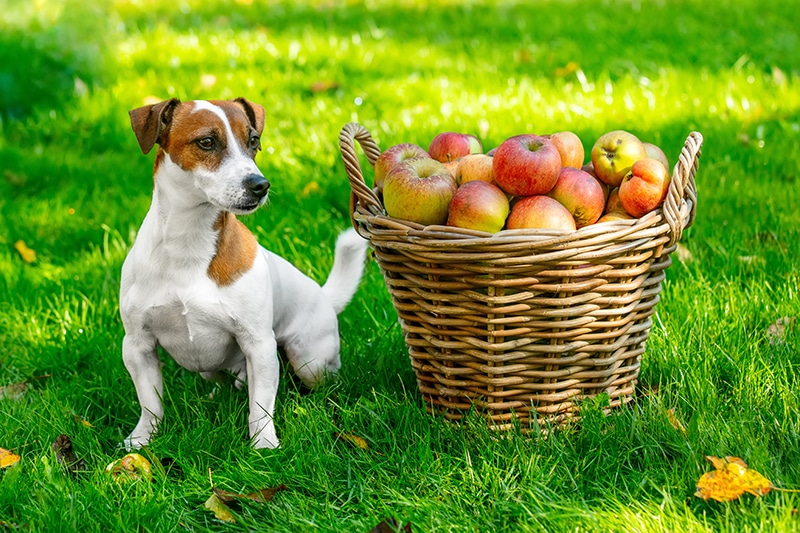You may be thinking that dogs don’t need fruits and vegetables in their diets because they’re descendants of wolves. But think again. Today’s domestic canines can benefit from the dietary fiber and other valuable nutrients these foods add to their daily intake.
In practice, whenever I had to treat dogs with digestive upset, dietary fiber played a key role. Whether the patient struggled with diarrhea or constipation, the right balance of soluble fiber and other nutrients helped restore the gut to normal function. Dietary fiber was also an important component for overweight and diabetic dogs.
There are many ways to boost a dog’s dietary fiber. One option is to feed your furbaby supplemental fruits and vegetables. You can choose from a variety of healthy options that are also rich sources of antioxidants and other nutrients. But not all fruits and vegetables are safe or beneficial for your dog to eat.
Sometimes, dogs need higher levels of fiber in their diets, such as when they have anal gland problems or diabetes. In these cases, regular commercial dog foods and supplementation with fruits and vegetables may not provide enough fiber. Talk to your veterinarian about high-fiber dog food, treats, or fiber supplements to determine what’s best for your pooch. Follow your dog doctor’s recommendations to prevent feeding too much fiber.
Natural Sources of Fiber You Can Add to Your Dogs Diet
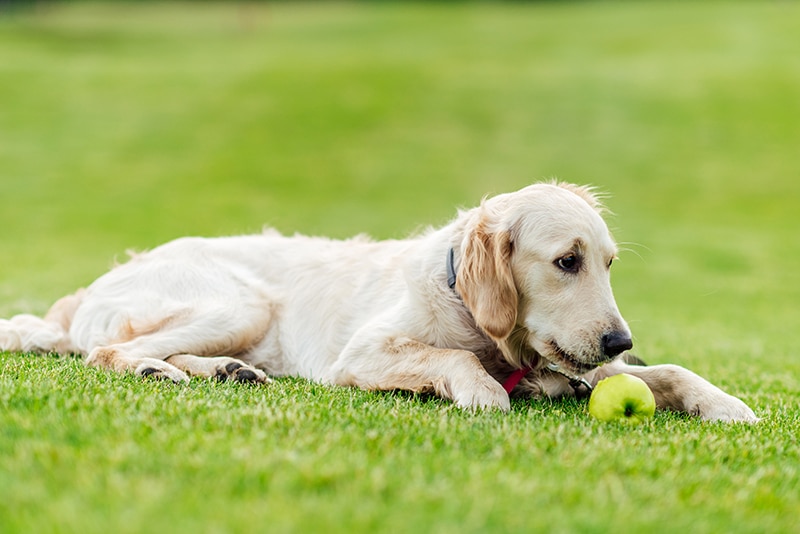
When you’re adding fiber to your dog’s diet, there are several fruits and vegetables that you can safely offer as a treat or as part of his meal. In addition to fiber, most of these foods are also excellent sources of antioxidants and other nutrients. In the list below, you’ll find dog-safe options for Fido.
Fruits
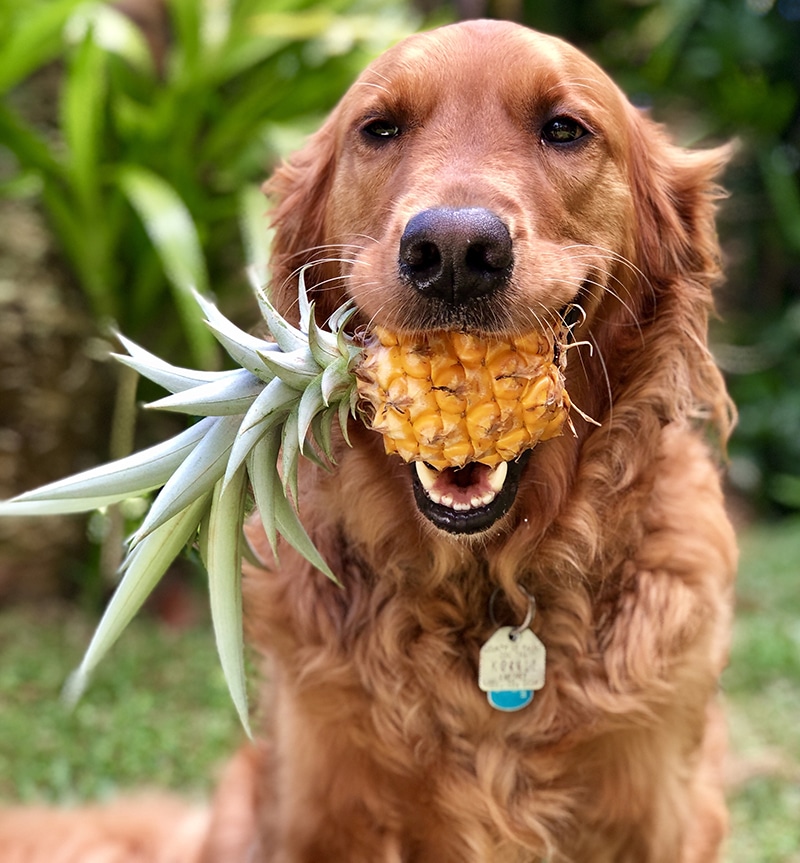
- Apples are not only a high-fiber food that dogs can eat but they’re also packed with nutrients. With vitamins A and C, antioxidants, and pectin, this fruit makes a healthy, low-fat, low-calorie snack. Including the skin is a great idea because it’s rich in antioxidants. You can feed your pooch slices or pieces of apple fresh or frozen for a cool summer treat. Do not feed the seeds or core of the apple.
- Bananas are tasty sources of fiber and key nutrients like copper, potassium, and vitamins. They’re low in sodium and cholesterol, so they’re heart-healthy. However, bananas are high in sugar, so offer these treats in moderation. And don’t feed the peel. You can slice and freeze them for a refreshing snack, mash them and mix them with dinner, or pack some mashed banana into a kong.
- Berries like blueberries, cranberries, raspberries, and strawberries are natural sources of fiber, antioxidants, phytochemicals, and vitamins. They’re easy to rinse off and serve as a snack or fun food topper. But be careful you don’t overdo it, or your pup may get the runs!
- Cantaloupe is full of fiber and water, but it’s also full of sugar. Feed frozen or fresh pieces to your pooch, but offer it in moderation.
- Coconut, although more of a seed or drupe, is an excellent source of antioxidants and lauric acid, which is an anti-inflammatory compound. You can feed the coconut meat in small portions to your pooch or add a little as a dog food topper. Don’t overdo it because too much may cause stomach upset.
- Mangoes are a rich source of several nutrients including vitamins A, B6, C, and E. Also including potassium and carotenoids, this food is a healthy source of fiber. Feed it in moderation because of the high sugar content. You can offer your pal pieces of fresh or frozen mango but remove the pit first.
- Oranges provide several health benefits for dogs but some pooches don’t like the strong citrus aroma. Full of essential nutrients like vitamin C, calcium, magnesium, and potassium, this fiber-rich fruit helps to boost the immune system and promote strong bones. It’s best to feed peeled oranges after you remove the seeds. A few slices can make a tasty treat.
- Peaches can be served fresh or frozen as long as you fully remove the pit. Full of fiber and vitamin A, this fruit can help your pooch fight infections. Don’t use canned peaches because they can contain added sugars or syrup.
- Pears, in addition to being a rich source of fiber, have potassium, copper, vitamin C, and vitamin K. The soluble fiber in pears binds with bile salts and safely removes them from the body which boosts intestinal health. You can feed your pooch bite-sized pieces of fresh or frozen pears as a treat, but don’t let them have the pit.
- Pineapple is a tasty treat that’s safe to feed to your pooch. Remove the crown and outer skin first, then cut it into bite-sized pieces. This fruit contains B vitamins, vitamin C, copper, magnesium, and more. Because it also has bromelain, a digestive enzyme, it helps your pooch absorb proteins more efficiently.
- Watermelon is a fantastic, low-calorie treat for your pooch. As the name suggests, it’s packed with water and can help your pal stay hydrated on a hot day. In addition to fiber and water, this tasty treat contains vitamins A, B6, C, and potassium. Remove the rind and seeds and feed fresh or frozen bite-sized bits. You can also puree the watermelon and freeze it into ice cubes or blend frozen chunks with plain, unsweetened yogurt.
Vegetables
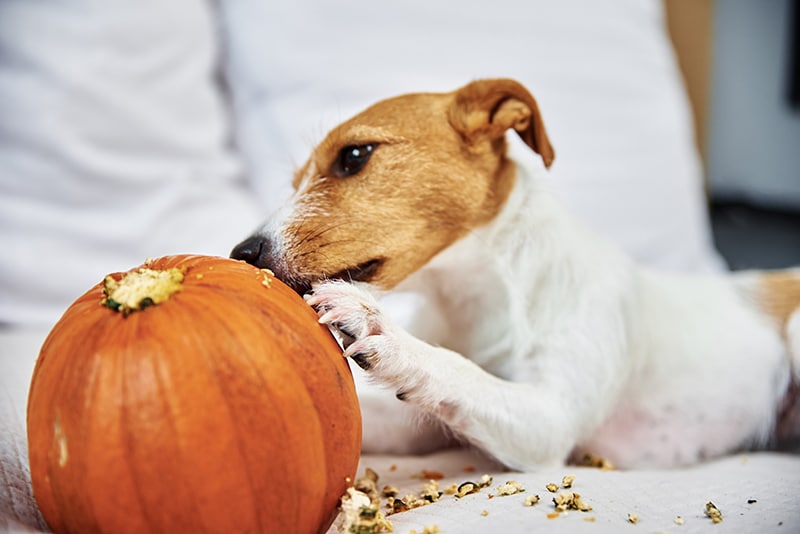
- Broccoli is safe for some dogs, but you should feed it in small quantities. The florets contain isothiocyanates which can irritate the stomach. This vegetable has vitamins A, C, and D along with minerals like calcium and chromium. Beta carotene and other phytochemicals help to boost your pup’s immunity. You can feed this treat raw or cooked, but cut it into small pieces and watch your pup. The stalks can get caught in the esophagus and cause choking.
- Brussel sprouts are loaded with vitamins A, B1, B6, C, and K, as well as antioxidants. You can safely feed cooked, unseasoned Brussel sprouts to your pooch. The best way to cook them is by steaming because it preserves the most nutrients. Make sure they’re cool before you offer them as a treat. Since these mini-cabbages can produce gas, feed only a few sprouts on an occasional basis.
- Carrots make a crunchy canine snack. They’re packed with fiber, vitamin C, beta-carotene, and antioxidants. Favored by many pups, these veggies are great for your pal’s teeth and eyes. For maximum impact, feed them raw. It’s best to cut the carrots into bite-sized chunks.
- Celery is another crunchy food that’s packed with fiber and nutrients. It contains vitamins A, C, K, and folate, along with the minerals potassium and manganese. As a bonus, it may help freshen the breath. Cut into bite-sized treats and feed in moderation.
- Cauliflower can safely be fed to your pooch in small quantities. As a fiber-rich food that’s also full of vitamin K, C, folate, calcium, and potassium. It supports a healthy immune system and digestion. You can feed it to your furbaby cooked, mashed, or finely chopped.
- Green Beans are safe for dogs whether they’re canned, chopped, raw, or steamed. With valuable nutrients such as vitamins A and C, calcium, phosphorus, iron, and omega fatty acids, these vegetables help to promote strong bones and support the cardiovascular system. If you opt for canned beans, go with low sodium or no added salt. Feed unseasoned green beans in bite-sized cuts to prevent choking.
- Peas including sugar snap peas, snow peas, green peas, and garden peas are ok as an occasional treat unless your furbaby has kidney disease. They’re rich in protein, vitamins A, B, and K, and minerals like iron, potassium, and zinc. You can feed peas fresh, frozen, or thawed. It’s best to avoid canned peas due to their sodium content.
- Potatoes which are baked or boiled and plain are safe to feed to most dogs. You should never feed raw potato because it contains a toxic substance called solanine. Cooking alters this compound so that it’s not dangerous. Potatoes are excellent sources of fiber. Sweet potatoes are a more nutritious option than white potatoes because they contain vitamins A, B6, and C along with essential minerals like calcium, iron, potassium, and magnesium. They’re also high in carbohydrates, so feed in moderation and don’t give them to diabetic dogs.
- Pumpkin is packed with fiber and essential nutrients. It’s rich in carotenoids, minerals like iron and potassium, and vitamins A, C, and E. This treat can be given to your dog canned, cooked, or pureed(after cooking). You can also roast fresh pumpkin seeds for a crunchy treat for adult dogs. Don’t add any oil or salt when roasting, and let the seeds cool before offering them to Fido. Do not feed pumpkin pie or pumpkin pie mix to dogs as it may contain ingredients that are dangerous for your furbaby.
Pumpkin is popular in preventing Anal Gland issues and is being almost exclusively used by Glandex, a leading brand in Anal Gland supplements.
Foods Not Recommended As Sources of Fiber for Dogs
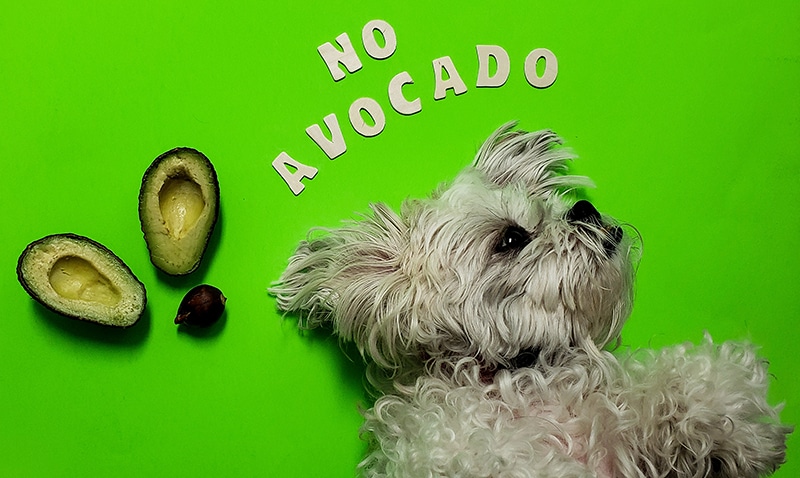
The fruits and vegetables listed below are materials that you probably shouldn’t give your pup as an added fiber source. Some of these items may be safe but are not the best choice for supplemental feeding while others are dangerous and could be deadly to feed to your pooch.
Fruits to Avoid
- Avocado contains persin which can cause vomiting and diarrhea in some dogs. The highest concentrations of persin are in the skin, pits, and leaves. But the flesh still contains enough to potentially trigger digestive upset. It’s best to not feed this to your pooch.
- Cherry plants contain the poison cyanide. While the fleshy part of the fruit doesn’t have the toxin, the rest of the fruit does. This substance interferes with oxygen transport in the cells. If a dog eats cherries, he may have red gums, dilated pupils, or difficulty breathing.
- Currants, Grapes, and Raisins are dangerous for canines. They contain an unidentified toxin that can cause kidney failure. Never feed these fruits to your dog.
- Tomatoes contain a toxic compound called solanine. It’s mainly concentrated in the green parts of the plant. The leaves, stems, and unripe fruit are very dangerous for dogs to eat. Fortunately, ripe tomatoes pose a very low risk. Still, it’s better to choose other food options.
Vegetables to Avoid
- Asparagus may be safe for dogs to eat, but it doesn’t pack the same value as other options. When it’s raw, the vegetable is tough and could be a choking hazard. Cooked asparagus can be mushy and unappetizing, and the cooking process diminishes the nutritional value. Your pooch will fare better eating other fruits or vegetables.
- Mushrooms are not advised. While some varieties are healthy, others contain potent toxins. Rather than taking the risk of giving your dog poisonous food, it’s best to avoid them altogether.
- Onions should never be fed to dogs, and it’s not just because of bad breath. These vegetables contain a dangerous substance called N-propyl disulfide that destroys red blood cells and causes anemia. Dogs may also experience upset stomachs, vomiting, and diarrhea if they eat onion.
- Rhubarb leaves and stems both contain oxalic acid which can cause kidney failure and deplete the body’s calcium levels. If you’re baking with rhubarb, make sure your furbaby can’t get any.
- Spinach leaves are high in oxalic acid which can cause kidney damage and interfere with calcium absorption. It’s best to avoid feeding spinach to your dog.
When Should You Add Fruit & Vegetable Fiber to Your Dog’s Diet?
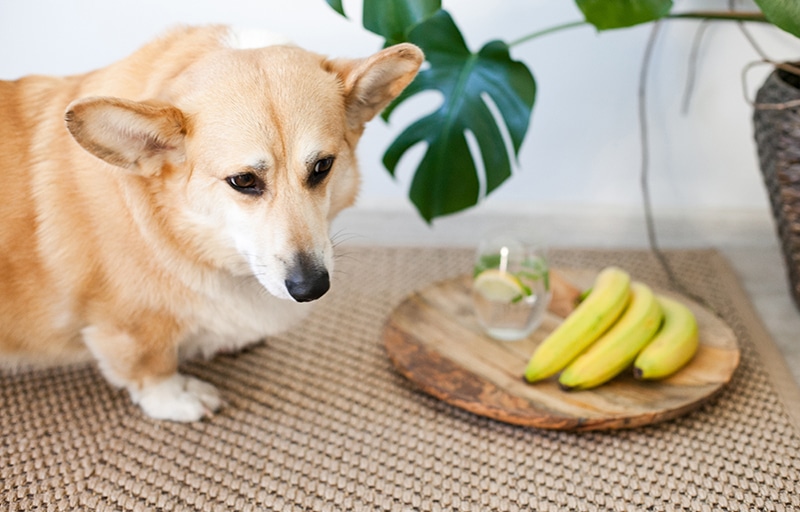
You should add fruit and vegetable fiber to your dog’s diet if she has certain digestive issues, including constipation, diarrhea, and anal gland problems. Many obese dogs and pups with diabetes can also benefit from added fiber.
- Anal gland Issues can often be improved by adding soluble fiber to the diet. This material absorbs excess liquid in the gut and helps to firm up the stool. Solid poops apply pressure on the anal sacs and encourage evacuation of the oily contents.
- Dogs with diarrhea can benefit from sources of soluble fiber like plain canned pumpkin. Soluble fiber absorbs excess liquid in the gut thus adding bulk to the stool. It’s also a source of prebiotics that support the growth of healthy intestinal bacteria.
- Dogs with constipation can also benefit from added fiber. Pumpkin and other fiber-rich foods help to stimulate motility and soothe the gut. Before adding fiber to your pal’s diet, make sure your pooch is well hydrated and talk to your veterinarian. There may be an underlying health condition like an obstruction or enlarged prostate.
- For obese dogs, adding fiber to the diet may help with weight loss. Fiber-rich foods like fruits and vegetables generally add bulk to the diet without the extra calories.
- In the case of diabetes, fiber moderates how quickly glucose enters the blood, and it helps your dog feel full longer. As a result, it may reduce insulin resistance and blood glucose spikes.
Fruit & Vegetable Fiber vs. Fiber Supplements
The difference between fruit and vegetable fiber and fiber supplements is that the fiber content of whole foods may not be high enough for dogs that require a high-fiber diet. Supplements are concentrated fiber extracts from plant materials, so they can help to achieve higher levels of fiber in the diet.
The fiber in fruits and vegetables contributes to your dog’s daily needs. Food-based sources of fiber generally also add flavor, texture, and essential nutrients. Healthy Many pups get the bulk they need from their daily food and healthy snacks. However, if your furbaby has a health condition that calls for added fiber, relying on fruits and vegetables may not be enough. That’s where supplements come in.
Fiber supplements can vary widely. They may contain soluble fiber, which can dissolve in water, insoluble fiber, or both. These products are fibers that have been isolated or extracted from their food source. As a result, supplements are concentrated forms of fiber. If your pooch’s diet lacks sufficient fiber to meet his needs, you may need to add small quantities of a fiber supplement. Consult with your veterinarian to help you choose the best product.
The bottom line is that if you have a healthy pooch you can supplement the diet with tasty fruits and vegetables. However, if your furbaby requires a high-fiber diet for health reasons, you’ll probably need to use supplements to boost his fiber to acceptable levels.
Fruit & Vegetable Fiber vs. High Fiber Dog Food
The difference between fruit and vegetable fiber and high-fiber dog food is that high-fiber dog food is usually formulated for specific health conditions and may contain 6-10% crude fiber. You can also increase daily fiber by feeding your pup fruits and vegetables. Always check with your veterinarian before making changes to his diet.
Dog food normally contains about 2-5% fiber. However, some special formulations have higher levels between 6 and 10% to help address issues like anal glands, diabetes, colitis, or weight loss. These products tend to include ingredients like beet pulp, whole grains, fruits, and vegetables. Many of them are designed by veterinarians and nutritionists and may require a prescription.
The fiber your pooch gets from fruits and vegetables can supplement his daily fiber intake. These ingredients may be tasty treats or toppers. Although you don’t need a prescription to feed your dog fruit and vegetable snacks, it’s wise to consult with your veterinarian about the quantity and frequency.
The bottom line here is that if your dog’s health calls for increased dietary fiber and your veterinarian recommends a special diet, you should select high-fiber dog food. On the other hand, if you’re trying to boost the amount of roughage to keep your pooch regular, try adding some fruits or vegetables.
Fruit & Vegetable Fiber vs. High Fiber Dog Treats
The difference between fruit and vegetable fiber and high-fiber treats is that treats have higher levels of fiber. A few tidbits a day can boost your pal’s daily fiber intake. However, they may not contain the antioxidants and other nutrients that you can find in fruits and vegetables.
High-fiber dog treats can be used in place of other biscuits. They come in a range of flavor and texture options including crunchy biscuits and soft chews. Some brands may include probiotic microorganisms or digestive enzymes to boost gut function. Their blend of ingredients offers an easy way to increase your pal’s dietary fiber intake.
Fruits and vegetables won’t provide the same level of fiber as high fiber treats, but they contain other essential nutrients and antioxidants. Like treats, you can choose from a variety of flavors and textures of whole foods to find the best fit for your pooch. Using fruits and vegetables to supplement dietary fiber is likely to be more affordable than high-fiber treats.
The bottom line here is that you can replace your normal treats with high-fiber options when your special pal needs more fiber to help treat a condition such as anal gland impaction or constipation. If you’re just trying to give your pooch extra roughage, try swapping his biscuits with apple slices, carrots, or another healthy option.
5 Ways to add High Fiber Fruits & Vegetables to your dog’s diet
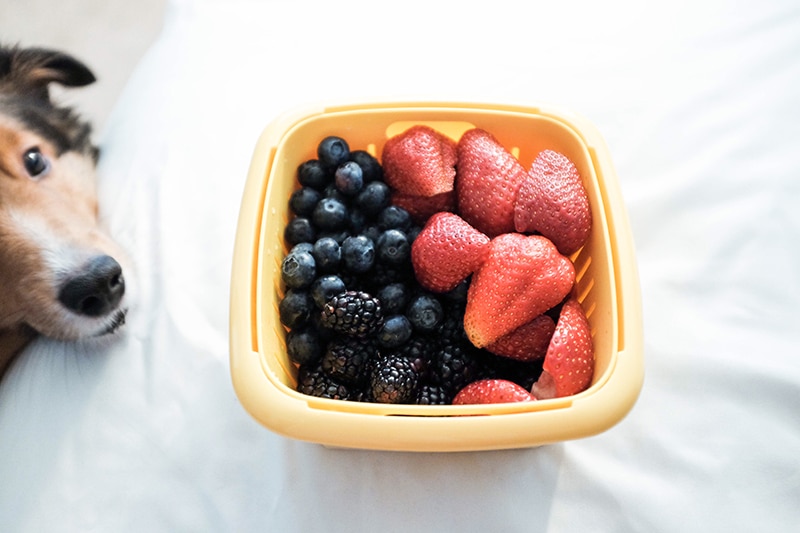
Below, we discuss five ways you can use fruits and vegetables to add fiber to your dog’s diet. You can use one or several of these tips to increase your pal’s roughage. As always, keep the treats in moderation.
- Add canned or freshly steamed pumpkin to your dog’s food. You can use plain pumpkin or pure as a fiber supplement in your dog’s food. Start in small quantities until you know how your pup tolerates the material. You can add up to 1 teaspoon of pumpkin for every 10 pounds of body weight.
- Mix steamed mashed sweet potato to Fido’s dinner. You can skin and chop a sweet potato and cook the pieces in the microwave until they’re soft. Mash the potato and allow it to cool then add about 1 teaspoon per 10 pounds of body weight to Fido’s meal.
- Offer sliced apples as a tasty treat. Replace your pup’s snack food with sliced or chopped apple pieces that are appropriate for your pup’s size. Always check to make sure you completely remove the seeds and core.
- Keep a bag of baby carrots handy for a healthy snack. Most dogs love the sweet crunch of a raw carrot. Use these orange treats in place of biscuits and chews.
- Add chopped, steamed green beans to your dog’s food. You can lightly steam or cook green beans in the microwave and chop them into small pieces to mix into your pup’s kibble. You can also use other acceptable vegetables such as cauliflower or Brussel sprouts.
The Risk of Too Much Fiber in the Diet
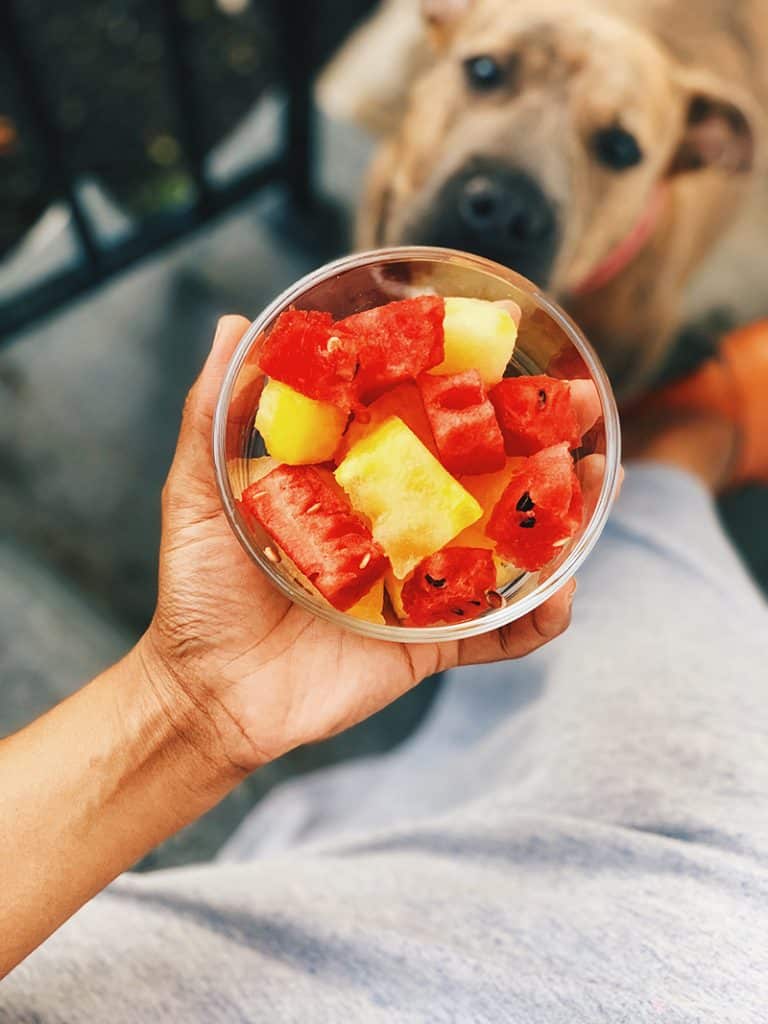
The risk of adding too much fiber to your dog’s diet is undesirable digestive symptoms like extra poop and flatulence. Excessive levels of insoluble fiber can also interfere with proper digestion and absorption of other nutrients. In this case, you may see weight loss, a poor coat, or vomiting. When adding fiber to the diet, the key is moderation.
The Final Woof

Our bottom line is there are a variety of fruits and vegetables that are safe to feed your pooch. These materials offer fiber and other valuable nutrients, but they should only be fed supplementally and in moderation. And not all fruits and vegetables are dog-friendly. Some contain toxins or provide little to no benefit to your pooch.
Unless your furbaby requires a high-fiber diet to treat a particular condition like anal gland problems, diarrhea, or obesity, supplemental feeding with fruits and vegetables should be all you need to boost her daily fiber intake.
If Fido needs extra roughage, talk to your veterinarian to determine whether you should feed a special high-fiber diet, use fiber supplements, or invest in high-fiber treats. When feeding a high fiber diet, remember to practice moderation.

